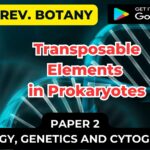EUPLOIDY
- It means presence of chromosome number which is similar multiple of basic chromosome number, or variation involve in entire sets of chromosomes.
- Each set of chromosomes is designated by the letter n and the numerical prefix refers to the number of sets or the level of ploidy.
Haploidy
- Haploid number of chromosomes is normally found in gametes of diploid (2n) organisms, but sometimes the whole organism may be haploid.
- Lower organism like bacteria and fungi are haploid for most of their life and become diploid or partially diploid for only a brief period.
Monoploidy and haploidy
- A distinction should be made between monoploidy and haploidy. Monoploidy have a single basic set of chromosomes e.g. 2n = x = 7 in barley or 2n = x = 10 in corn.
- Haploids, on the other hand represent individuals having half the somatic chromosome number found in normal individual.
- Therefore, individuals having 2n = 3x = 21 in wheat would also be haploids.
- These latter kind of haploids obtained from polyploids are often called polyhaploids in order to distinguish them from monoploids.
- While reviewing the work on haploids in flowering plants in 1963, G. Kimber and R. Riley (now, John Inner Centre or JRC, Norwich, UK), gave a classification for haploids.
- They classified haploids in euhaploids and aneuhaploids which as the term indicate are derived from euploids and aneuploids respectively.
- A modified classification given by K. J. Kasha is presented. Euhaploids will include monohaploids as well as polyhaploids.
Origin, Occurence and Production of Haploids
- The haploids may originate at different points during the life cycle.
- Their spontaneous production may be facilitated by environmental factors and these may also be produced in the laboratory by artificial methods.
- Based on the point in the life cycle involved, haploid production systems can be broadly classified in three main categories namely:
i) parthenogenesis and apogamy,
ii) chromosome elimination and
iii) culture methods
1. Production of haploids through parthenogenesis and apogamy
- The development of an embryo from the egg cell without the participation of a male gamete is parthenogenesis, and when the embryo develops from any other gametophytic cell other than egg cell without fertilization, it is apogamy.
- There are varieties of methods, which bring about parthenogenetic production of haploids like:
a. Spontaneous- .
- It is largely due to parthenogenetic development of egg or any other cell of the embryo sac.
b. Artificial treatments–
- The induction of haploids can be facilitated due to different treatments like irradiation treatment including X-rays and UV rays, hot and cold temperature shocks, wounds or injury, and chemical treatment
c. Delayed pollination-
- A delay in pollination has also been found to induce parthenogenetic development of egg into a haploid embryo.
d. Wide hybridization–
- In this method, when a suitable pollinator is used, pollen stimulates the development of embryo without fertilization.
2. Production of haploids through chromosome elimination
- Cases are known where either spontaneously or due to specific treatments, the chromosome number was reduced to half in the somatic tissues, a phenomenon described as somatic reduction or reductional mitosis.
- Swaminathan and Singh (1958) induced a haploid branch of watermelon by irradiation of the seed used.
3. Production of haploids through culture methods
a. Through anther and pollen culture.
- It is one of the popular methods for production of haploids using artificial culture medium.
- This leads to the growth of microspores into sporophytes.
b. Through ovule culture.
- Haploids have also been successfully produced from cultured female gametophytes.
- Haploidy is common in plants but rare in animals except some diploid species of insects, rotifers, mites, etc., which produce haploid males parthenogenetically.
- In haploids each chromosome represented only once due to which there is no zygotene pairing and all the chromosomes appear as univalents on a metaphase plate at the time of meiosis.
- During anaphase each chromosome moves independently of the other and goes to either of the poles.
- According to the law of probability the chance that a particular chromosome will go to a particular pole is half and the chance that all the chromosomes of a haploid set will go to the same is ½ x ½ x ½…n times, where n = number of chromosomes in the haploid set.
- Therefore, the frequency of gametes with the haploid set or n number of chromosomes will be (½)n.
- This indicates that higher the number of chromosomes in a haploid set, lesser will be the frequency of all of them being included in the same gamete.
- Gametes with less than the haploid number of chromosomes are normally not viable.
- Haploid organism, therefore, are highly sterile.
- Male bees and such haploid animals are exceptions and in them there is no meiosis at the time of gamete formation.
- Cells arising as a result of mitosis get differentiated into sperms and are, therefore, haploid and viable.
- Haploid individuals usually develop abnormally in many diploid animals.
- Amphibian haploids have been induced by various means, but the embryos rarely reach the adult stage.
- In many plants, such as Nicotiana, Datura, Oiyza, Secale etc., fully viable haploids can be formed, but they turn out to be sterile because meiosis produces inviable gametes.
- In all organisms’ haploid and diploid generations alternate but in evolved organisms, like higher plants and animals, the diploid generation predominates and the haploid generation is transitory and short lived.
- As we go down the evolutionary scale, the balance shifts in favour of the haploid generation, so much so that in micro-organisms major part of the life span is haploid.
- During haploid state there is only one copy of each chromosome and only one allele of each gene.
- Consequently, each gene is expressed whether it is dominant or recessive.
- This facilitates genetic experiments and this is the reason why micro-organisms have been helpful in genetic studies.
- For the same reason scientists are trying to develop haploid strains of flowering plants.
- Success has been achieved in developing haploid strains of Nicotiana, Datura, Triticum, etc., but the problem of their poor growth and sterility has yet to be overcome.
- Haploid strains of crop are useful in another way.
- Present day diploid and polyploidy species are the result of evolution through ages and inconceivable diversity and heterozygosity has been generated due to mutation and recombination.
- Heterozygosity is a hindrance in plant breeding because the recessive genes keep on appearing during successive generations.
- If the chromosome number of a haploid strain is duplicated, a diploid will arise which will be homozygous for all the characters and genes. Such a strain will be an ideal starting material for crop breeding.
- This is the reason why biologists are synthesizing haploid strains of crops like rice, wheat, etc.
- It was Maheshwari and Guha (1966) of Delhi University who, for the first time, were successful in obtaining haploid plants of tobacco by culturing anthers on suitable media. Since then this technique has been used for developing haploids in a number of plants. In the same department Sinha and Bhojwani have been able to induce haploidy in somatic cells of onion by growing the roots in a medium containing para-fluorophenylalanine.
- Chemical induction of haploidy in higher plants, if successful on a large scale, will be a very useful tool in the hands of plant breeders.






